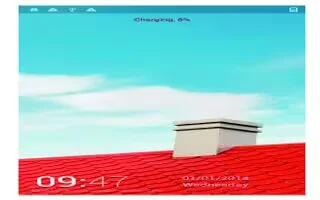Learn how to use home screen on your Gionee Elife E7 Mini. The main home screen is the starting point for many applications and functions, and it allows you to add items like application icons, shortcuts, folders, or Google widgets to give you instant access to information and applications.
- This is the default page and accessible from any menu by pressing Home Key.
Navigating Through the Home Screens
Your phone originally has four home screens but you can expand up to seven home screens. If you like, you can place different applications on each of the home screens.
- From the main Home screen, sweep the screen with your finger in either direction. The main Home Screen is located in the middle with a Home screen on each side.
Navigating Through the Application Menus
Your phone initially has three Application Menus available. Follow these steps to navigate through the Application Menus:
- At the Home screen, tap Apps icon. The first Application Menu will be displayed.
- Sweep the screen left or right to access the other two menus.
- Tap one of the application icons.
Note: As you add applications, the number of Application menus that you have available will increase.
Navigating Using Sub-Menus
Sub-menus are available when you are at any Home screen or have selected a feature or application such as Phone, Contacts, Messaging, or Internet.
To access a sub-menu:
- Press Menu Key. A sub-menu will appear at the bottom of the phone screen.
- Tap an option.
The Home screen is your starting point to access all the features on your phone. It displays application icons; You can customize the Home screen with different wallpaper and display the items you want. At the top of the screen, the Status bar displays the time, information about the status of your phone, and icons for notifications that youve received.
Using the touch screen
The main way to control Android features is by using your finger to touch icons, buttons, menu items, the onscreen keyboard, and other items on the touch screen.
- Touch: To act on items on the screen, such as application and settings icons, to type letters and symbols using the onscreen keyboard, or to press onscreen buttons, you
simply touch them with your finger. - Touch & hold: Touch & hold an item on the screen by touching it and not lifting your finger until an action occurs.
- Drag: Touch & hold an item for a moment and then, without lifting your finger, move your finger on the screen until you reach the target position. You drag items on the Home screen to reposition them
- Swipe or slide: To swipe or slide, you quickly move your finger across the surface of the screen, without pausing when you first touch (so you dont drag an item instead). For example, you slide the screen up or down to scroll a list, and in some Calendar views you swipe quickly across the screen to change the range of time visible.
- Double-tap: Tap quickly twice on a webpage, map, or other screen to zoom. For example, you can double-tap a section of a webpage in Browser to zoom that section to fit the width of the screen. In Maps, and in other applications, Double-tapping after pinching to zoom in some applications, such as browser, reflows a column of text to fit the width of the screen.
- Pinch: In some applications (Such as Maps, Browser, and Gallery) you can zoom in and out by placing two fingers on the screen at once and pinching them together (to zoom out) or spreading them apart (to zoom in).
- Rotate the screen: On most screens, the orientation of the screen rotates with the phone as you turn it from upright to its slide and back again. You can turn this feature on and off.
